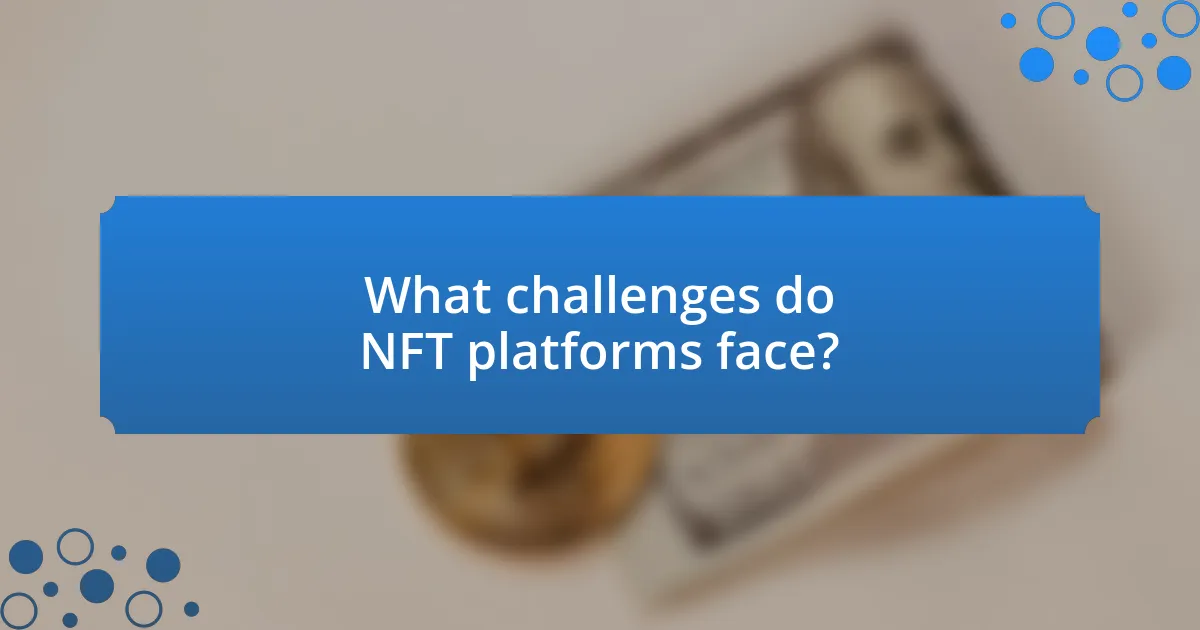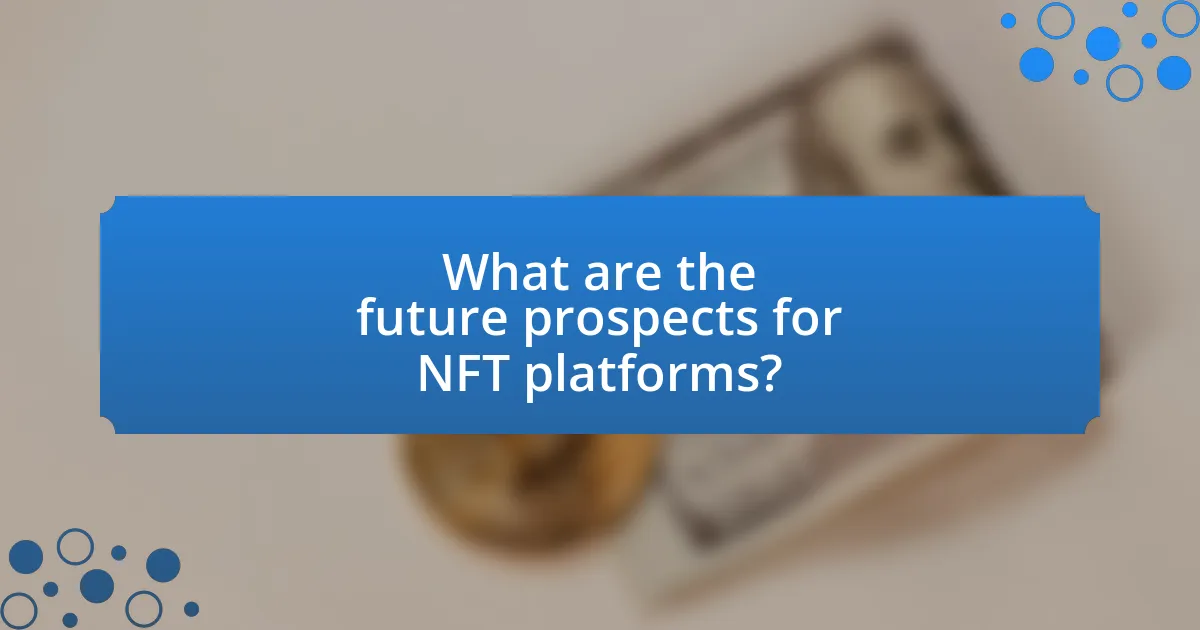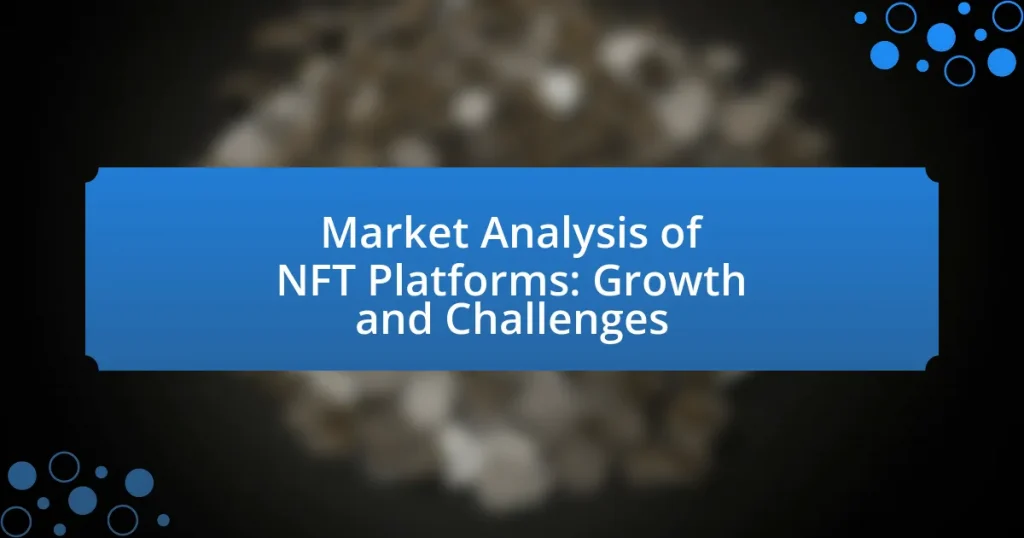The article provides a comprehensive market analysis of NFT platforms, highlighting their growth and the challenges they face. It details the current state of the NFT market, noting a significant decline in trading volume since its peak in 2021, alongside the evolution of NFT platforms from niche marketplaces to mainstream ecosystems. Key technological advancements, shifts in consumer interest, and the impact of regulatory issues are examined, along with the roles of major players like OpenSea and Ethereum. The article also discusses future prospects for NFTs, potential applications across various industries, and best practices for users navigating this volatile market.

What is the current state of the NFT market?
The current state of the NFT market is characterized by a significant decline in trading volume and interest compared to its peak in 2021. In 2023, the NFT market has seen a reduction in sales, with monthly trading volumes dropping to approximately $300 million, down from over $4 billion in early 2022. This decline is attributed to various factors, including market saturation, regulatory scrutiny, and a shift in consumer interest towards more traditional investments. Additionally, the number of active wallets engaging in NFT transactions has decreased, indicating a contraction in the user base.
How have NFT platforms evolved over the past few years?
NFT platforms have significantly evolved over the past few years, transitioning from niche marketplaces to mainstream ecosystems. Initially, platforms like CryptoKitties and OpenSea focused primarily on digital art and collectibles, but the market has expanded to include music, gaming, virtual real estate, and more. According to a report by NonFungible.com, the NFT market grew from approximately $250 million in 2020 to over $10 billion in 2021, showcasing a dramatic increase in user engagement and transaction volume. Additionally, major brands and celebrities have entered the space, further legitimizing NFTs and driving innovation in platform features, such as enhanced user interfaces, lower transaction fees, and cross-chain compatibility. This evolution reflects a broader acceptance of blockchain technology and digital ownership, positioning NFT platforms as integral components of the digital economy.
What technological advancements have influenced NFT platforms?
Blockchain technology is the primary technological advancement that has influenced NFT platforms by providing a decentralized and secure method for verifying ownership and authenticity of digital assets. This technology enables the creation of unique tokens that represent ownership of digital items, ensuring transparency and immutability in transactions. Additionally, advancements in smart contracts have allowed for automated and programmable transactions, enhancing the functionality of NFTs by enabling features such as royalties for creators upon resale. The Ethereum blockchain, which introduced the ERC-721 standard for NFTs, has been pivotal in this evolution, facilitating a wide range of applications from digital art to virtual real estate. Furthermore, improvements in scalability solutions, such as Layer 2 protocols, have addressed transaction speed and cost issues, making NFT trading more accessible to a broader audience.
How has consumer interest shifted in the NFT space?
Consumer interest in the NFT space has shifted from speculative investments to a focus on utility and community engagement. Initially, many consumers were drawn to NFTs primarily for their potential as speculative assets, leading to a surge in high-profile sales and market volatility. However, recent trends indicate a growing preference for NFTs that offer real-world applications, such as access to exclusive content, events, or services, reflecting a maturation of the market. According to a report by NonFungible.com, the number of active wallets interacting with NFTs has increased, indicating a shift towards sustained engagement rather than one-time purchases. This evolution highlights a broader understanding of NFTs as tools for community building and brand loyalty, rather than mere collectibles.
What are the key players in the NFT platform market?
The key players in the NFT platform market include OpenSea, Rarible, Foundation, SuperRare, and Nifty Gateway. OpenSea is the largest NFT marketplace, facilitating millions of transactions and hosting a vast array of digital assets. Rarible is notable for its decentralized governance model, allowing users to participate in platform decisions through its RARI token. Foundation focuses on high-quality art and has gained popularity among artists and collectors. SuperRare emphasizes unique, high-value digital art, while Nifty Gateway is known for its partnerships with well-known brands and artists, offering exclusive drops. These platforms collectively dominate the NFT space, driving innovation and market growth.
Which platforms dominate the market and why?
Ethereum and OpenSea dominate the NFT market due to their extensive user bases and robust ecosystems. Ethereum serves as the primary blockchain for NFT transactions, hosting a majority of NFT projects, which enhances its liquidity and attractiveness to creators and collectors. OpenSea, as the largest NFT marketplace, facilitates a wide range of digital assets and boasts significant trading volume, making it a go-to platform for users. According to DappRadar, OpenSea accounted for over 90% of the NFT market share in 2021, highlighting its dominance. The combination of Ethereum’s established infrastructure and OpenSea’s user-friendly interface and vast selection solidifies their leading positions in the market.
How do emerging platforms challenge established players?
Emerging platforms challenge established players by introducing innovative business models and leveraging technology to capture market share. For instance, platforms like OpenSea and Rarible have disrupted traditional marketplaces by offering decentralized transactions and lower fees, attracting both creators and consumers. According to a report by NonFungible.com, the NFT market grew to over $10 billion in 2021, indicating a significant shift in consumer preference towards these new platforms. This growth demonstrates how emerging platforms can rapidly gain traction and influence, forcing established players to adapt or risk losing relevance.
What factors contribute to the growth of NFT platforms?
The growth of NFT platforms is primarily driven by increased consumer interest, technological advancements, and the expansion of digital art and collectibles markets. Increased consumer interest is evidenced by the surge in NFT sales, which reached approximately $25 billion in 2021, up from just $100 million in 2020, indicating a significant rise in market engagement. Technological advancements, particularly in blockchain technology, enhance security and transparency, making NFT transactions more appealing to users. Furthermore, the expansion of digital art and collectibles markets has attracted artists and creators, leading to a diverse range of offerings on NFT platforms, which in turn fuels further growth.
How does the integration of blockchain technology enhance NFT platforms?
The integration of blockchain technology enhances NFT platforms by providing a decentralized and secure framework for ownership verification and transaction processing. This technology ensures that each NFT is unique and cannot be duplicated, as it is recorded on a public ledger that is immutable and transparent. For instance, Ethereum, the most widely used blockchain for NFTs, allows for smart contracts that automate transactions and enforce ownership rights without intermediaries. This reduces the risk of fraud and increases trust among users, as evidenced by the significant growth in NFT sales, which reached $10.7 billion in Q3 2021, highlighting the demand for secure and verifiable digital assets.
What role do digital art and collectibles play in market expansion?
Digital art and collectibles significantly contribute to market expansion by attracting new audiences and creating additional revenue streams. The rise of NFTs (non-fungible tokens) has enabled artists and creators to monetize their work directly, leading to a surge in digital art sales. In 2021, the NFT market reached a valuation of approximately $41 billion, demonstrating its rapid growth and influence on the broader art market. This expansion not only increases the visibility of digital art but also encourages traditional collectors to engage with digital formats, thereby broadening the overall market landscape.

What challenges do NFT platforms face?
NFT platforms face several significant challenges, including scalability, environmental concerns, and regulatory issues. Scalability is a major hurdle as many platforms struggle to handle high transaction volumes, leading to slow processing times and increased fees. For instance, Ethereum, the most widely used blockchain for NFTs, has faced congestion issues, resulting in transaction costs that can exceed $100 during peak times. Environmental concerns arise from the energy-intensive processes associated with blockchain transactions, particularly those using proof-of-work mechanisms, which have drawn criticism for their carbon footprint. Regulatory issues also pose a challenge, as governments worldwide are still developing frameworks to govern digital assets, creating uncertainty for platforms and users alike. This regulatory ambiguity can hinder innovation and deter potential investors.
How do regulatory issues impact NFT platforms?
Regulatory issues significantly impact NFT platforms by influencing their operational frameworks and compliance requirements. These platforms must navigate a complex landscape of laws related to intellectual property, securities, and consumer protection, which can affect their ability to operate and innovate. For instance, in 2021, the U.S. Securities and Exchange Commission (SEC) indicated that certain NFTs could be classified as securities, requiring platforms to adhere to stricter regulations. This classification can lead to increased costs for compliance, potential legal liabilities, and limitations on the types of NFTs that can be offered. Additionally, regulatory uncertainty can deter investment and innovation within the NFT space, as platforms may hesitate to launch new features or services without clear guidelines.
What are the current regulations affecting NFT transactions?
Current regulations affecting NFT transactions primarily involve securities laws, anti-money laundering (AML) requirements, and consumer protection laws. In the United States, the Securities and Exchange Commission (SEC) has indicated that certain NFTs may be classified as securities, which would subject them to registration requirements under the Securities Act of 1933. Additionally, the Financial Crimes Enforcement Network (FinCEN) mandates that NFT platforms comply with AML regulations, requiring them to implement Know Your Customer (KYC) processes. Furthermore, various states have begun to introduce specific legislation addressing digital assets, which can impact how NFTs are bought, sold, and traded. These evolving regulations aim to provide clarity and protect consumers while fostering innovation in the NFT market.
How do different countries approach NFT regulation?
Different countries approach NFT regulation with varying degrees of clarity and enforcement. For instance, the United States has a fragmented regulatory landscape where NFTs may be classified under existing securities laws, depending on their characteristics, as indicated by the SEC’s guidance. In contrast, the European Union is working towards a comprehensive regulatory framework through the Markets in Crypto-Assets (MiCA) proposal, which aims to provide clear guidelines for digital assets, including NFTs. Meanwhile, countries like China have taken a restrictive stance, banning cryptocurrency transactions and imposing strict regulations on digital assets, which affects NFT trading. These diverse regulatory approaches reflect each country’s economic priorities and legal frameworks, influencing how NFTs are developed and traded within their jurisdictions.
What are the technological challenges for NFT platforms?
NFT platforms face several technological challenges, including scalability, interoperability, and security. Scalability issues arise as the demand for NFTs increases, leading to network congestion and high transaction fees, particularly on platforms like Ethereum, which can process only a limited number of transactions per second. Interoperability challenges occur when NFTs created on one blockchain cannot be easily transferred or utilized on another, limiting their usability across different platforms. Security concerns are prevalent due to the risk of hacks and fraud, as evidenced by significant thefts in the NFT space, highlighting the need for robust security measures to protect digital assets.
How do scalability issues affect user experience on NFT platforms?
Scalability issues significantly degrade user experience on NFT platforms by causing slow transaction times and high fees. When a platform cannot handle increased demand, users may experience delays in buying, selling, or minting NFTs, leading to frustration and potential loss of interest. For instance, during peak times, Ethereum-based NFT platforms have seen gas fees soar to hundreds of dollars, making transactions economically unfeasible for many users. This not only discourages participation but also limits the accessibility of NFTs to a broader audience, ultimately stifling market growth.
What security concerns are prevalent in the NFT market?
Security concerns prevalent in the NFT market include smart contract vulnerabilities, phishing attacks, and the risk of counterfeit NFTs. Smart contracts, which govern the transactions and ownership of NFTs, can contain coding errors that hackers exploit, leading to significant financial losses. Phishing attacks target users through deceptive websites or communications, tricking them into revealing private keys or sensitive information. Additionally, the lack of standardized verification processes allows for the creation and sale of counterfeit NFTs, undermining the authenticity and value of legitimate digital assets. These issues highlight the need for enhanced security measures and user education within the NFT ecosystem.
How does market volatility affect NFT platforms?
Market volatility significantly impacts NFT platforms by influencing buyer sentiment and transaction volume. When market conditions are unstable, potential buyers may hesitate to invest in NFTs due to uncertainty about future value, leading to decreased sales and lower prices. For instance, during periods of high volatility in cryptocurrency markets, which often underpin NFT transactions, platforms have experienced sharp declines in trading activity; in early 2022, NFT sales dropped by over 50% as cryptocurrency prices fluctuated dramatically. This correlation indicates that NFT platforms are sensitive to broader market trends, affecting their overall growth and sustainability.
What factors contribute to price fluctuations in NFTs?
Price fluctuations in NFTs are primarily influenced by demand and supply dynamics, market sentiment, and the uniqueness of the digital asset. Demand for NFTs can vary significantly based on trends, celebrity endorsements, and community engagement, which can drive prices up or down. Supply is often limited, as many NFTs are one-of-a-kind or part of a small collection, creating scarcity that can increase value. Market sentiment, influenced by broader cryptocurrency trends and economic conditions, also plays a crucial role; for instance, a bullish market can lead to higher prices, while bearish trends can cause declines. Additionally, the perceived value of an NFT, based on its artistic merit, utility, or historical significance, can further contribute to its price volatility.
How do market trends influence user trust in NFT platforms?
Market trends significantly influence user trust in NFT platforms by shaping perceptions of value and security. When the market experiences a surge in demand for NFTs, users are more likely to perceive these platforms as reputable and reliable, leading to increased trust. For instance, during the NFT boom in early 2021, platforms like OpenSea saw a dramatic rise in user engagement and transactions, which reinforced user confidence in their security measures and overall legitimacy. Conversely, during market downturns or instances of high-profile scams, such as the 2022 NFT market crash, user trust can diminish rapidly, as potential buyers become wary of investing in platforms perceived as unstable or unsafe. This correlation between market performance and user sentiment underscores the importance of market trends in establishing and maintaining trust in NFT platforms.

What are the future prospects for NFT platforms?
The future prospects for NFT platforms are promising, driven by increasing adoption across various industries, including art, gaming, and real estate. As of 2023, the NFT market has shown resilience, with a reported market size of approximately $24.9 billion in 2021, projected to grow significantly as more businesses integrate NFTs into their operations. This growth is supported by advancements in blockchain technology, which enhance security and scalability, making NFT transactions more efficient. Additionally, the rise of metaverse platforms is expected to create new opportunities for NFT utilization, further expanding their market presence.
How can NFT platforms innovate to overcome current challenges?
NFT platforms can innovate to overcome current challenges by implementing enhanced user experience features, improving scalability, and adopting eco-friendly technologies. Enhanced user experience can be achieved through intuitive interfaces and educational resources that simplify the onboarding process for new users, addressing the complexity that often deters participation. Improving scalability involves optimizing blockchain technology to handle increased transaction volumes without compromising speed or security, as evidenced by Ethereum’s transition to a proof-of-stake model, which aims to enhance efficiency. Additionally, adopting eco-friendly technologies, such as layer-2 solutions or alternative blockchains with lower energy consumption, can address environmental concerns that have been a significant barrier to broader acceptance. These innovations not only enhance user engagement but also align with growing consumer demand for sustainability in digital assets.
What new features could enhance user engagement on NFT platforms?
New features that could enhance user engagement on NFT platforms include gamification elements, social interaction tools, and enhanced customization options. Gamification can increase user participation by incorporating rewards, challenges, and leaderboards, which have been shown to boost user retention and activity in digital environments. Social interaction tools, such as chat functions and community forums, can foster a sense of belonging and encourage users to share experiences, thereby increasing platform stickiness. Enhanced customization options allow users to personalize their profiles and NFT displays, which can lead to a more engaging and tailored experience. These features align with trends observed in successful digital platforms, where user engagement is significantly correlated with interactive and community-driven functionalities.
How can NFT platforms improve security and trustworthiness?
NFT platforms can improve security and trustworthiness by implementing robust smart contract audits and utilizing decentralized storage solutions. Smart contract audits identify vulnerabilities in the code, reducing the risk of hacks; for instance, platforms like OpenSea have adopted third-party audits to enhance their security measures. Additionally, decentralized storage solutions, such as IPFS, ensure that NFT data is not reliant on a single point of failure, thereby increasing data integrity and availability. These practices not only protect users’ assets but also foster greater confidence in the platform’s reliability, as evidenced by the growing adoption of these security measures across leading NFT marketplaces.
What role will NFTs play in the broader digital economy?
NFTs will serve as a transformative asset class in the broader digital economy by enabling ownership, provenance, and monetization of digital assets. They facilitate direct transactions between creators and consumers, eliminating intermediaries and enhancing revenue streams for artists and content creators. According to a report by NonFungible.com, the NFT market reached a valuation of approximately $10.7 billion in 2021, demonstrating significant growth and interest. This growth indicates that NFTs are not only reshaping the art and entertainment sectors but also expanding into industries like gaming, real estate, and virtual goods, thereby integrating into various economic models.
How might NFTs integrate with other digital assets and currencies?
NFTs can integrate with other digital assets and currencies through interoperability protocols and blockchain technology. This integration allows NFTs to be traded across various platforms and ecosystems, enhancing their liquidity and utility. For instance, NFTs can be linked to cryptocurrencies like Ethereum, enabling seamless transactions and ownership verification. Additionally, platforms like OpenSea and Rarible facilitate the exchange of NFTs for different cryptocurrencies, demonstrating practical applications of this integration. The rise of cross-chain solutions further supports this by allowing NFTs to move between different blockchain networks, thereby expanding their market reach and usability.
What potential applications of NFTs could emerge in various industries?
Potential applications of NFTs could emerge in various industries such as art, gaming, real estate, and entertainment. In the art industry, NFTs can provide artists with a way to tokenize their work, ensuring provenance and enabling direct sales to collectors, as evidenced by the $69 million sale of Beeple’s digital artwork as an NFT. In gaming, NFTs can represent in-game assets, allowing players to truly own, trade, and sell items across different platforms, which has been demonstrated by games like Axie Infinity, where players earn real income through gameplay. In real estate, NFTs can streamline property transactions by representing ownership and title deeds digitally, enhancing transparency and reducing fraud risks. In the entertainment sector, NFTs can be used for exclusive content access, such as behind-the-scenes footage or special edition releases, as seen with musicians like Kings of Leon releasing album NFTs. These applications illustrate the versatility of NFTs across multiple sectors, driving innovation and new revenue streams.
What best practices should NFT platform users follow?
NFT platform users should follow best practices such as conducting thorough research on projects before investing, using secure wallets, and being cautious of scams. Researching projects helps users understand the value and potential of NFTs, as evidenced by the significant number of failed projects in the NFT space, which highlights the importance of due diligence. Utilizing secure wallets, such as hardware wallets, protects users’ assets from hacks, as over $2 billion worth of NFTs were stolen in 2021 alone. Additionally, being cautious of scams, including phishing attempts and fake marketplaces, is crucial, as the NFT market has seen a rise in fraudulent activities, with reports indicating that 80% of NFTs on some platforms may be scams.
How can users ensure safe transactions on NFT platforms?
Users can ensure safe transactions on NFT platforms by verifying the authenticity of the NFT and the credibility of the platform. This involves checking the platform’s security features, such as two-factor authentication and encryption, and researching the NFT’s provenance through blockchain records. According to a report by NonFungible.com, over 80% of NFT scams are linked to phishing attacks, highlighting the importance of using reputable platforms and being cautious of unsolicited communications. Additionally, users should only transact with verified wallets and avoid sharing private keys to protect their assets.
What strategies can users employ to navigate market volatility?
Users can employ diversification, risk management, and staying informed as strategies to navigate market volatility. Diversification involves spreading investments across various assets to reduce risk; for instance, holding a mix of NFTs, cryptocurrencies, and traditional assets can mitigate losses during downturns. Risk management includes setting stop-loss orders to limit potential losses and only investing what one can afford to lose, which is crucial in the highly speculative NFT market. Staying informed about market trends, regulatory changes, and technological advancements allows users to make timely decisions, as evidenced by the rapid shifts in NFT valuations influenced by market sentiment and external factors.


